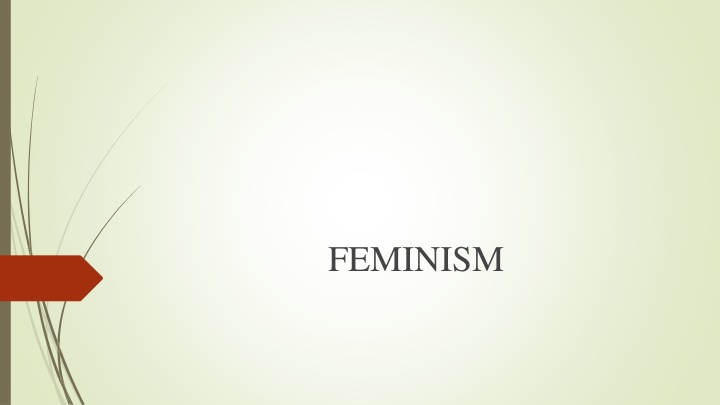
Understanding Feminism: A Movement for Gender Equality
Feminism is a social, political, and cultural movement advocating for gender equality and empowering women by challenging traditional norms. Learn about its history, key figures, types, and feminist criticism in this comprehensive guide.
Download Presentation

Please find below an Image/Link to download the presentation.
The content on the website is provided AS IS for your information and personal use only. It may not be sold, licensed, or shared on other websites without obtaining consent from the author. If you encounter any issues during the download, it is possible that the publisher has removed the file from their server.
You are allowed to download the files provided on this website for personal or commercial use, subject to the condition that they are used lawfully. All files are the property of their respective owners.
The content on the website is provided AS IS for your information and personal use only. It may not be sold, licensed, or shared on other websites without obtaining consent from the author.
E N D
Presentation Transcript
FEMINISM Feminism is a movement characterized by various ideologies aimed at defining, establishing and defending equal political, economic, cultural, and social rights for women. It is a social, political, and cultural movement that advocates for gender equality and the empowerment of women. It seeks to challenge and change the traditional norms, values, and power structures that oppress and marginalize women. Feminism promotes gender equity in all spheres of life, including education, work, and politics.
Some of the first advocates of women's emancipation Olympe de Gouges: Wrote the Declaration of the Rights of Woman and Female Citizen of 1791, dedicated to Marie Antoinette. De Gouges served his pro-monarchist political moderation and Girondin (was denounced by the Republican Women of Paris) ending up on the guillotine in 1793. The English Mary Wollstonecraft: Wrote in her A Vindication of the Rights of Woman that: "it is time to make a revolution in the ways of life of women - it is time to restore the lost dignity - and make them, as part of the human species, operate by reforming themselves to reform the world .
After the French revolution Mary Wollstonecraft argued that the ideal of the revolution and Enlightenment should be extended to women, primarily through access to education. The history of women were not only deprived of education and financial independence. Had to struggle against a male ideology condemning them to virtual silence and obedience. The depiction of women in male literature- as angels, goddesses, whores, obedient wives, and mother figures. Indeed such depiction was an essential means of perpetuating these ideologies of gender.
FEMINIST CRITICISM Since the early twentieth century, feminist criticism has grown to include a vast of series of concerns: rewriting of literary history so as to include the contribution of women; 1. the tracing of a female literary tradition. 2. theories of sexuality and sextual differences, drawing on psychoanalysis, Marxism, and social sciences. 3. the representation of women in male literature. 4. The role of gender in both literary creation and literary criticism.
TYPE OF FEMINISM There are several types of feminism, including liberal feminism, radical feminism, socialist feminism, and cultural feminism. Liberal feminism focuses on achieving gender equality by working within the existing structure of society. Liberal feminism believes in the importance of individual rights and equal opportunities for women, as well as working within the existing system to achieve gender equality. Radical feminism seeks to eliminate patriarchy and transform the social structure. It challenge traditional gender roles, and create a society free from gender- based oppression.
TYPE OF FEMINISM Socialist feminism aims to address the connections between gender and economic inequality. Advocating for the redistribution of power and resources to achieve gender equality. Radical feminism focuses on addressing the root causes of gender inequality and challenging traditional gender roles, while socialist feminism emphasizes the economic and class dimensions of gender oppression. Cultural feminism emphasizes the importance of women's unique qualities and contributions.
THREE WAVES OF FEMINISM The first wave of feminism, which occurred in the late 19th and early 20th centuries, focused on women's suffrage and legal rights, such as property ownership and divorce laws. The second wave of feminism, which emerged in the 1960s and 1970s, addressed broader issues such as reproductive rights, workplace discrimination, and sexual harassment, The third wave of feminism, which began in the 1990s, emphasized diversity, individuality, and the intersectionality of gender with other social categories such as race, class, and sexuality. The first wave focused on legal and political rights, the second wave expanded to social and economic issues, and the third wave emphasized personal empowerment and inclusivity. Each wave had its own set of challenges and accomplishments
